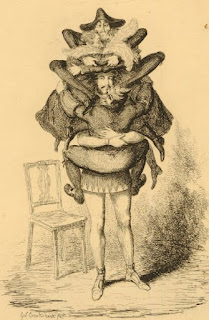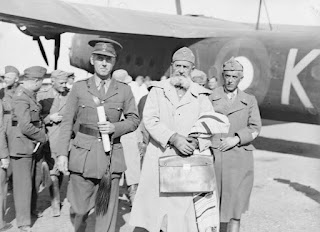NEW - Giovanni Battista Belzoni – archaeologist
The Great Belzoni’s powerful physique helped him remove Egyptian treasures
Explorer and pioneer archaeologist of Egyptian antiquities, Giovanni Battista Belzoni, was born on this day in 1778 in Padua, which was then part of the Republic of Venice. He became famous for his height and strength and his discovery and removal to England of the seven-ton bust of Ramesses II. Belzoni was born into a poor family. At the age of 16 he went to find work in Rome and studied hydraulics. He was planning to take monastic vows but in 1798 French troops occupied the city and he moved to the Batavian Republic, now the Netherlands, where he earned his living as a barber. He moved to England in 1803, allegedly to escape going to prison. He was six feet seven inches tall and had a powerful physique. For a while he earned his living as a circus strongman under the name, The Great Belzoni. He also exhibited his models of hydraulic engines and went to Cairo in 1815 to offer hydraulic engines for use in irrigation to Muhammad Ali Pasha, the founder of modern Egypt. But two years later he embarked on another new career, excavating Egyptian tombs and temples for their treasures. It was said he damaged other less valuable objects in the process, which was later frowned upon. Read more…
___________________________________________________________
Francesco Chiarello - survivor of two World Wars
Calabrian veteran lived to be 109 years old
Francesco Domenico Chiarello, who would live to be one of the world's longest surviving veterans to serve in both World Wars, was born on this day in 1898. Chiarello was 109 years old when he died in June 2008. Of soldiers anywhere on the planet who were active in the 1914-18 conflict and were called up again after 1939, only the Frenchman Fernand Goux outlived him. Goux, from the Loiret department of central northern France, died just five months later, aged 108. Chiarello also died as one of the last two surviving Italian soldiers from the First World War, outlived only by Delfino Borroni, from just outside Pavia in Lombardy, who was a tram driver during the Second World War. Borroni recovered from serious injuries sustained in an Allied bombing raid to be 110 years old when he died four months after Chiarello. Chiarello, a farmer from Umbriatico in the province of Crotone in Calabria, joined the Italian army in 1918 as a member of the 19th infantry regiment from Cosenza. He was sent to the northern front at Trento where he took part in the final Battle of Vittorio Veneto, a seminal moment in the history of the conflict and of Italy. Read more…
____________________________________________________________
Pietro Longhi - painter
Painter who allowed us to see inside 18th century Venice
The painter Pietro Longhi, who was renowned for his accurate scenes of everyday life in Venice in the 18th century, was born on this day in 1702. Longhi was originally called Pietro Falca and was the son of a silversmith in Venice, but he changed his name after he began painting. He started with historical and religious scenes but his work evolved after a stay in Bologna where he encountered Giuseppe Maria Crespi, who was considered one of the greatest Italian painters at the time. Longhi’s son Alessandro later wrote that his father had a ‘brilliant and bizarre spirit’, which led him to accurately paint people in conversation and show us the love and jealousy going on in the background. His paintings vividly depict Venetian life and show wonderful details of the clothes and possessions of the upper and middle classes. For example, Longhi’s painting of The Hairdresser and the Lady, which is in the Correr Museum in Venice, shows a wealthy Venetian lady having her hair dressed by a man, while a maid stands to one side holding a child. Longhi faithfully shows us how the clothing of each subject reflects the rank of the person wearing it and allows us to see the various objects scattered on the lady’s dressing table. Read more…
__________________________________________________________
Attilio Ariosti – composer
Musical friar was once a rival of Handel
Baroque composer Attilio Malachia Ariosti, who in later life became a rival of Handel in London musical circles, was born on this day in 1666 in Bologna. He became a Servite Friar, known as Frate Ottavio, when he was 22, but he quickly obtained permission to leave the order and become a composer at the court of the Duke of Mantua and Monferrato. During his life, Ariosti composed more than 30 operas and oratorios as well as many cantatas and instrumental works. Ariosti became a Deacon in 1692 and then obtained the post of organist at the Church of Santa Maria dei Servi in Bologna. His first opera, Tirsi, was performed in Venice in 1697 and that same year he was invited to travel to Berlin by Sophia Charlotte of Hanover, the Queen of Prussia. She was a great-granddaughter of James I of England and the daughter of the Electress Sophia of Hanover, a committed patron of the arts with a keen interest in music. The Electress Sophia had been heir presumptive to the throne of the Kingdom of Great Britain and was waiting for the death of her first cousin once removed, Queen Anne, before travelling to Britain to claim her title. Read more…
___________________________________________________________
Alessandro Malaspina - explorer
Mapped Pacific on four-year epic journey
Alessandro Malaspina, an explorer not so well known as his compatriots, Amerigo Vespucci and Christopher Colombus, but whose contribution to mankind’s knowledge of the globe was no less important, was born on this day in 1754 in Mulazzo, a village now in the province of Massa-Carrara, about 120km (75 miles) northwest of Florence. Like Vespucci and Columbus, Malaspina sailed under the flag of Spain, whose king, Charles III, was an enthusiastic supporter of scientific research and exploration. He spent much of his life as an officer in the Spanish navy, and it was after completing an 18-month circumnavigation of the world on behalf of the Royal Philippines Company between September 1786 and May 1788 that he proposed to the Spanish government that he make an expedition to the Pacific similar to those undertaken by the British explorer James Cook and the Frenchman Comte de la Pèrouse. His proposal was accepted in part after word reached Spain that a Russian expedition was being prepared with the objective of claiming territory on the northwest coast of North America that had already been claimed by Spain. Read more…
___________________________________________________________
Filippo Taglioni - dancer and choreographer
Father of star ballerina was pioneer of Romantic ballet
The dancer and choreographer Filippo Taglioni, who choreographed the original version of the ballet classic La Sylphide for his ballerina daughter Marie Taglioni, was born on this day in 1777 in Milan. La Sylphide was one of the earliest works to represent a new ballet genre, which became known as Romantic ballet, that gained popularity in the 19th century as an alternative to traditional classical ballet. Romantic ballet was different in that the characters were recognisable as real people rather than the gods and goddesses and strange creatures from Roman and Greek mythology that populated classical ballet. The work, which premiered at the Salle Le Peletier of the Paris Opéra in 1832, cemented Marie Taglioni’s status as a star, the prima ballerina of the Romantic movement, although the version performed today - the only version to have survived - was choreographed by the Danish ballet master August Bournonville in 1836. Filippo was part of an Italian dancing dynasty of the 18th and 19th centuries. His father and mother, Carlo Taglioni and Maria Petracchi, were both dancers. Carlo, who was born in Turin, worked in Venice, Rome, Siena and Udine. Read more…

































